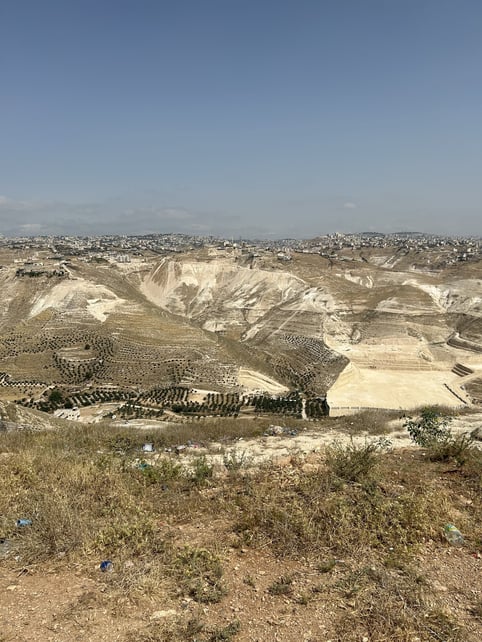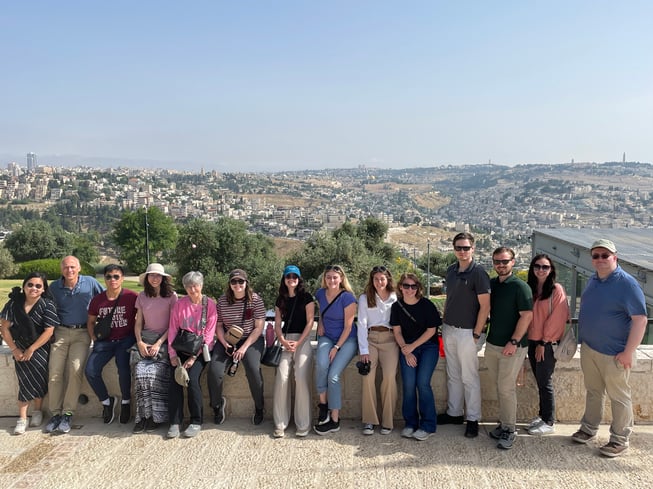Day Twelve – Scarce Water, but Plenty of Conflicts
By: Caleb Cook '25
This article is part of a series of reflections prepared by students enrolled in the Texas A&M School of Law 2023 Global Field Studies Program: Israel. Click here to visit the entire series.
As soon as I discovered that the law school offered overseas field classes, I was determined to go. I soon heard about this trip, which was devoted to two areas I had long been interested in: environmental law, and conflict resolution in Israel. After applying, fourteen other students and I were selected for this trip, ably guided by Professors Eckstein and Welsh, along with various affiliates of the Arava Institute for Environmental Studies.
 Traveling near Jerusalem
Traveling near Jerusalem
The eleventh day of our trip began with a guided bus tour through Wadi Kidron, otherwise known as the Kidron Valley. Our guide was Dr. Jawad Hasan Shoqeir, a water researcher at nearby al-Quds University. Along the way, he pointed out several interesting aspects of the area but paid particular attention to the difficulty of water management. The Kidron Valley begins near the Old City of Jerusalem and separates Jerusalem from the West Bank. It is the site of complex boundary disputes between Israel and Palestine. Israel holds de facto control over a portion of the West Bank and East Jerusalem (including the largely Arab Old City), while the Palestinian Authority has control of the rest of the West Bank and maintains de jure authority over the Israeli-occupied West Bank, including East Jerusalem.
These complex boundary disputes have made the disposal of wastewater from the contested areas of Jerusalem and the West Bank very challenging. Both the Palestinians and the Israelis felt that allowing the other to treat the sewage in the region would, in effect, help legitimize the other’s control of and rights to the area. For many years, therefore, raw sewage from certain areas of East Jerusalem, as well as surrounding communities in the West Bank, has flowed directly into the Wadi Kidron. While the two sides have attempted to negotiate a resolution to this issue, it still stands largely unresolved.
 View across the Kidron Valley, looking toward Jerusalem
View across the Kidron Valley, looking toward Jerusalem
After we left the Kidron Valley, we traveled further through the West Bank to the village of al-Auja, a small city located near the ancient city of Jericho. In al-Auja, we heard a lecture on several of the pressing transboundary environmental issues facing Israel from Nader Al-Khateeb, the current General Director of a Palestinian non-profit focused on water use and access. He paid particular attention to the disputes over water and energy between Israel and Jordan.
The Jordan River forms part of the border between Israel and Jordan, flowing from the Sea of Galilee in the north to the Dead Sea in the south, and has long been an important source of freshwater in the region. However, Israel and Jordan have both unilaterally diverted much of the water that had previously flowed into the river, leading to extreme reductions in water levels. This has posed problems for communities in Palestine and Jordan, many of which relied on the river for irrigation and other water needs. At the same time, many of the Palestinian, Israeli, and Jordanian communities in the area do not have adequate resources to build sewage treatment facilities, so they dump untreated sewage into the Jordan river. This has further reduced its viability as a source of potable water for the region. The reduced flow of water in the Jordan River has, in turn, threatened the existence of the Dead Sea. It no longer receives the water necessary to maintain a consistent water level and is further depleted by Israeli and Jordanian companies carrying out large-scale evaporation measures to extract minerals from the water.
Solutions to this problem are challenging because they require navigating the complex relationship between Israel, Palestine, and Jordan on top of difficult issues of engineering and ecology. For some time, a connection between the Red Sea and the Dead Sea was contemplated as a way to raise water levels in the Dead Sea, though the Jordanian government recently abandoned a unilateral effort to complete such a connection. For the time being, reaching a scientifically and politically sustainable solution to these overlapping issues seems incredibly difficult.
However, as Mr. Al-Khateeb mentioned, a new agreement reached between Jordan and Israel provides hope for future negotiations between the two countries. Jordan is severely lacking in water–it is among the most water-deficient countries in the world. As a result of desalination and wastewater recycling efforts, Israel is much better positioned in terms of water supply but has wanted to increase its green energy capacity. The two countries therefore negotiated an agreement under which Israel would build a new desalination plant to supply additional freshwater to Jordan. In exchange, Jordan would build a large solar energy farm and export the electricity produced to Israel. While the deal is encouraging, it is unfortunate that Palestinian voices were entirely excluded from the negotiations.
After the conclusion of this lecture and a quick lunch, our group traveled to the nearby Auja Spring, which is an important source of water for vegetation in the region. The spring makes the area a lush green oasis, standing in stark contrast to the surrounding desert. The spring also provides a popular aquatic recreational site for Palestinians, who are severely restricted from traveling outside Palestinian-controlled areas, and we saw several families picnicking nearby. Even in this peaceful setting, however, we were reminded of the fraught relationships in the area. As we drove by, we witnessed a young Palestinian teenager being questioned by the Israeli military on the side of the road.
After departing al-Auja, we traveled by bus back to our hostel in Jerusalem, where we had free time in the evening for exploration and dinner. Some of us went to eat at a nearby hummus restaurant, wandered around the busy Jaffa Street to get ice cream, and then returned to the hostel for a full night’s rest before a busy final day.
 A side street in Jerusalem near where we had ice cream
A side street in Jerusalem near where we had ice cream
As busy and informative as this day was, it was only a small taste of our incredible trip.
Learn more about Texas A&M University School of Law's Global Law and Policy Program, Aggie Dispute Resolution Program, and Energy, Environmental, and Natural Resource Systems Law Program
